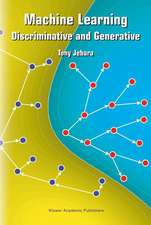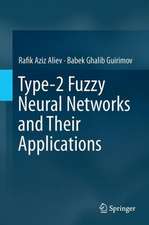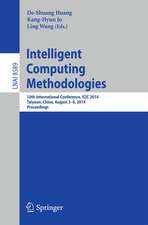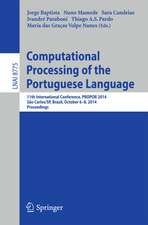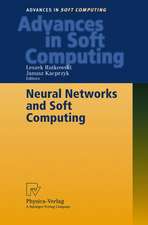Artificial Intelligence in Structural Engineering: Information Technology for Design, Collaboration, Maintenance, and Monitoring: Lecture Notes in Computer Science, cartea 1454
Editat de Ian Smithen Limba Engleză Paperback – 15 iul 1998
The recent advances in information technology, in particular decreasing hardware cost, Internet communication, faster computation, increased bandwidth, etc., allow for the application of new AI techniques to structural engineering. The papers presented deal with new aspects of information technology support for the design, analysis, monitoring, control and diagnosis of various structural engineering systems.
Din seria Lecture Notes in Computer Science
- 20%
 Preț: 1061.55 lei
Preț: 1061.55 lei - 20%
 Preț: 307.71 lei
Preț: 307.71 lei - 20%
 Preț: 438.69 lei
Preț: 438.69 lei - 20%
 Preț: 645.28 lei
Preț: 645.28 lei -
 Preț: 410.88 lei
Preț: 410.88 lei - 15%
 Preț: 580.46 lei
Preț: 580.46 lei - 17%
 Preț: 427.22 lei
Preț: 427.22 lei - 20%
 Preț: 596.46 lei
Preț: 596.46 lei -
 Preț: 449.57 lei
Preț: 449.57 lei - 20%
 Preț: 353.50 lei
Preț: 353.50 lei - 20%
 Preț: 1414.79 lei
Preț: 1414.79 lei - 20%
 Preț: 309.90 lei
Preț: 309.90 lei - 20%
 Preț: 583.40 lei
Preț: 583.40 lei - 20%
 Preț: 1075.26 lei
Preț: 1075.26 lei - 20%
 Preț: 310.26 lei
Preț: 310.26 lei - 20%
 Preț: 655.02 lei
Preț: 655.02 lei - 20%
 Preț: 580.93 lei
Preț: 580.93 lei - 20%
 Preț: 340.32 lei
Preț: 340.32 lei - 18%
 Preț: 938.83 lei
Preț: 938.83 lei - 20%
 Preț: 591.51 lei
Preț: 591.51 lei - 15%
 Preț: 438.59 lei
Preț: 438.59 lei - 20%
 Preț: 337.00 lei
Preț: 337.00 lei -
 Preț: 389.48 lei
Preț: 389.48 lei - 20%
 Preț: 607.39 lei
Preț: 607.39 lei - 20%
 Preț: 1024.44 lei
Preț: 1024.44 lei - 20%
 Preț: 579.30 lei
Preț: 579.30 lei - 20%
 Preț: 763.23 lei
Preț: 763.23 lei - 20%
 Preț: 453.32 lei
Preț: 453.32 lei - 20%
 Preț: 575.48 lei
Preț: 575.48 lei - 20%
 Preț: 585.88 lei
Preț: 585.88 lei - 20%
 Preț: 825.93 lei
Preț: 825.93 lei - 20%
 Preț: 763.23 lei
Preț: 763.23 lei - 17%
 Preț: 360.19 lei
Preț: 360.19 lei - 20%
 Preț: 1183.14 lei
Preț: 1183.14 lei - 20%
 Preț: 340.32 lei
Preț: 340.32 lei - 20%
 Preț: 504.57 lei
Preț: 504.57 lei - 20%
 Preț: 369.12 lei
Preț: 369.12 lei - 20%
 Preț: 583.40 lei
Preț: 583.40 lei - 20%
 Preț: 343.62 lei
Preț: 343.62 lei - 20%
 Preț: 350.21 lei
Preț: 350.21 lei - 20%
 Preț: 764.89 lei
Preț: 764.89 lei - 20%
 Preț: 583.40 lei
Preț: 583.40 lei - 20%
 Preț: 649.49 lei
Preț: 649.49 lei - 20%
 Preț: 341.95 lei
Preț: 341.95 lei - 20%
 Preț: 238.01 lei
Preț: 238.01 lei - 20%
 Preț: 538.29 lei
Preț: 538.29 lei
Preț: 343.29 lei
Preț vechi: 429.11 lei
-20% Nou
Puncte Express: 515
Preț estimativ în valută:
65.69€ • 68.77$ • 54.35£
65.69€ • 68.77$ • 54.35£
Carte tipărită la comandă
Livrare economică 05-19 aprilie
Preluare comenzi: 021 569.72.76
Specificații
ISBN-13: 9783540648062
ISBN-10: 3540648062
Pagini: 516
Ilustrații: XIV, 502 p.
Dimensiuni: 155 x 235 x 27 mm
Greutate: 0.72 kg
Ediția:1998
Editura: Springer Berlin, Heidelberg
Colecția Springer
Seriile Lecture Notes in Computer Science, Lecture Notes in Artificial Intelligence
Locul publicării:Berlin, Heidelberg, Germany
ISBN-10: 3540648062
Pagini: 516
Ilustrații: XIV, 502 p.
Dimensiuni: 155 x 235 x 27 mm
Greutate: 0.72 kg
Ediția:1998
Editura: Springer Berlin, Heidelberg
Colecția Springer
Seriile Lecture Notes in Computer Science, Lecture Notes in Artificial Intelligence
Locul publicării:Berlin, Heidelberg, Germany
Public țintă
ResearchCuprins
Structural monitoring of civil structures using vibration measurement Current practice and future.- Object-oriented software patterns for engineering design standards processing.- Design and verification of real-time systems.- Using knowledge nodes for knowledge discovery and collaboration.- Heating system design support.- Collaborative desktop engineering.- Towards personalized structural engineering tools.- Complex systems: Why do they need to evolve and how can evolution be supported.- Formalizing product model transformations: Case examples and applications.- Internet-based web-mediated collaborative design and learning environment.- Wearable computers for field inspectors: Delivering data and knowledge-based support in the field.- Conceptual designing as a sequence of situated acts.- Some personal experience in computer aided engineering research.- Knowledge discovery from multimedia case libraries.- Customisable knowledge bases for conceptual design.- Articulate design of free-form structures.- Applying quantitative constraint satisfaction in preliminary design.- Agents in computer-assisted collaborative design.- A collaborative negotiation methodology for large scale civil engineering and architectural projects.- An investigation into the integration of neural networks with the structured genetic algorithm to aid conceptual design.- Finding the right model for bridge diagnosis.- Knowledge-based assistants in collaborative engineering.- CAD modelling in multidisciplinary design domains.- A family of software components to deliver solutions for the interpretation of monitoring data.- AI methods in concurrent engineering.- A new collaborative design environment for engineers and architects.- Intelligent structures: A new direction in structural control.- Integrationof expert systems in a structural design office.- Teaching knowledge engineering: Experiences.- Design support for viaducts.- Converting function into object.- Software agent techniques in design.- Case-based design process facilitating collaboration and information evolution.- Shared experiences: Management of experiential knowledge in the building industry.- Dam safety: Improving management.- Integrating virtual reality and telepresence to remotely monitor construction sites: A ViRTUE project.- Proposal for 4.5 dimensional design via product models and expert system.- A product information system based on dynamic classification.- Structural monitoring: Decision-support through multiple data interpretations.- Augmented reality applications to structural monitoring.- Analysis and design of the as-built model.- On theoretical backgrounds of CAD.







